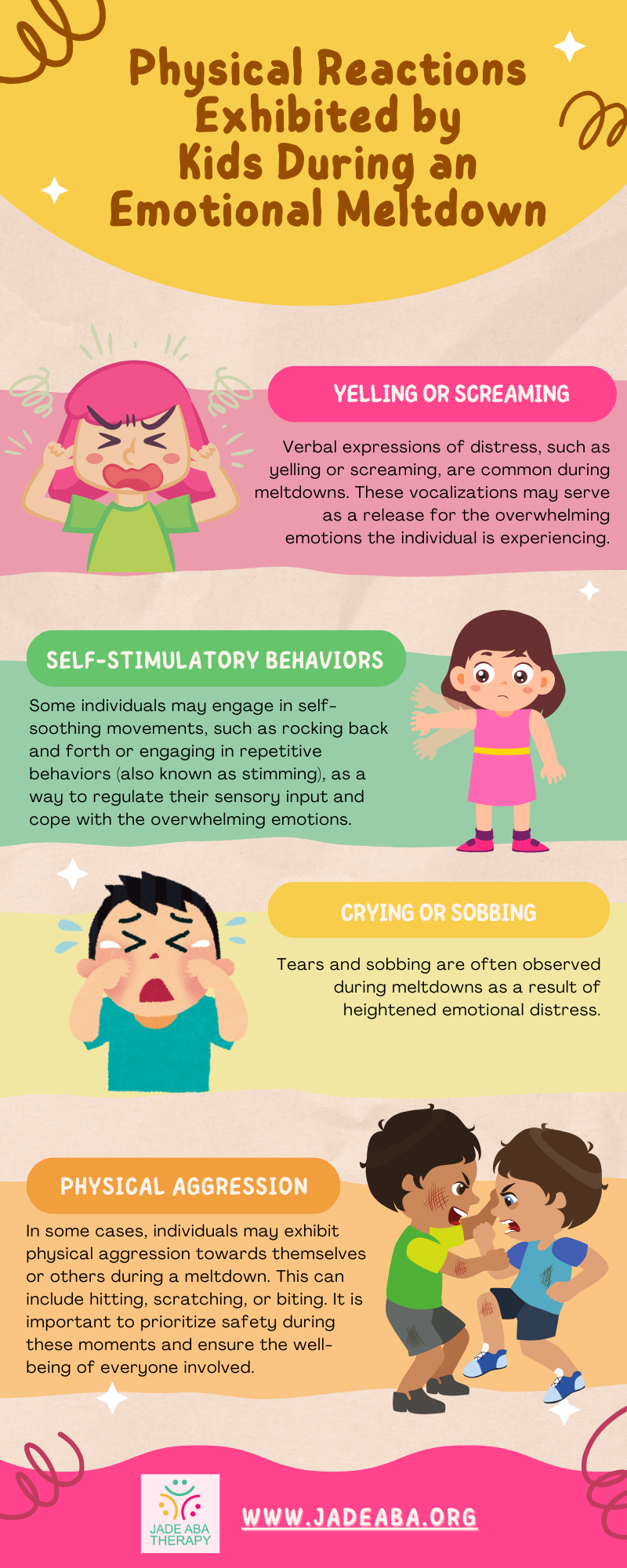An autistic meltdown is an involuntary response to nervous system overload which is a highly dysregulated state and a physical manifestation of a neurobiological reaction. Unlike temper tantrums, which are more common in young children, autistic meltdowns can occur in individuals of all ages, including older children, teenagers, and adults on the autism spectrum.
During a meltdown, an individual with autism experiences an overwhelming surge of emotions and sensory stimuli that surpass their ability to cope. This can result in a loss of control over their behavior, making it challenging for them to self-regulate or calm down.
It’s important to note that autistic meltdowns are genuine cries of distress and are not manipulative like tantrums.

Signs and Triggers
Recognizing the signs and triggers of an autistic meltdown is essential for parents and caregivers in providing appropriate support and intervention. Understanding the early warning signs and common triggers can help anticipate and manage meltdowns effectively.
Before an autistic meltdown occurs, individuals may exhibit early warning signs that signal their increasing distress. These signs are often a response to stress or sensory overload, rather than a form of manipulation.
Some common early warning signs include:
- Biting nails or fingers
- Covering ears or eyes
- Asking to leave or escape the situation
- Increased stimming behavior (self-stimulatory behaviors)
- Heightened anxiety or restlessness
- Becoming more withdrawn or non-communicative
Recognizing these early signs allows caregivers to intervene and provide support before the situation escalates into a full meltdown. It is important to create a safe and understanding environment where individuals feel comfortable expressing their distress and seeking help.

Common Triggers
A variety of factors can trigger autistic meltdowns, and each individual may have their own specific triggers. However, some common triggers include:
- Sensory overload (e.g., loud noises, bright lights, crowded spaces)
- Changes in routine or unexpected transitions
- Overstimulation from too much information or input
- Difficulties with communication or social interactions
- Challenges in managing emotions or frustration
- Sensitivities to specific textures, tastes, or smells (e.g., food aversions)
Identifying the specific triggers for an individual is crucial in developing strategies to prevent or manage meltdowns effectively. By understanding the triggers, caregivers can make adjustments to the environment, routines, or communication styles to minimize the likelihood of meltdowns occurring.

Behavior During Meltdowns
When an individual with autism experiences a meltdown, their behavior can be intense and overwhelming. Understanding the emotional responses and physical reactions that occur during meltdowns is crucial for providing effective support and assistance.
During an autistic meltdown, emotional responses can vary from individual to individual. However, some common emotional reactions may include:
- Overwhelming distress – Autistic meltdowns are genuine cries of distress that stem from a state of nervous system overload. The individual may feel overwhelmed, anxious, or scared, and these emotions can intensify during the meltdown.
- Heightened sensitivity – Sensory sensitivities are often heightened during a meltdown, making individuals more susceptible to environmental stimuli such as noise, lights, or textures. These sensory triggers can contribute to the emotional intensity of the meltdown.
- Difficulty communicating – Communication challenges may exacerbate emotional responses during meltdowns. The individual may struggle to express their needs or emotions verbally, leading to increased frustration or feelings of helplessness.
It is important to remember that meltdowns are not manipulative like tantrums. They are genuine expressions of distress and should be approached with empathy and understanding.
Physical Reactions
Autistic children and teenagers experiencing meltdowns may also exhibit physical reactions alongside their emotional responses. These physical reactions can vary, but they may include the following:

Autistic individuals experiencing meltdowns may also report physical sensations such as tension, difficulty breathing, heat, or blurry vision during the episode. These physical manifestations further emphasize the intense nature of the meltdown and the need for supportive strategies to help the individual regain control and find a sense of calm.
How to Manage Meltdowns
It is essential to employ effective support strategies and recovery techniques in order to manage meltdowns in individuals with autism. Understanding and implementing these strategies can help both the individual experiencing the meltdown and those providing support.
Support strategies are crucial in assisting individuals with autism during a meltdown. These strategies aim to provide comfort, guidance, and a safe environment. Ideally, you want to apply the following support strategies:
- Maintain Calm – It is important for caregivers to remain calm during a meltdown. This can help create a sense of stability and security for the individual. Speaking in a calm and reassuring tone can also help de-escalate the situation.
- Provide Structure – Establishing a predictable routine can be beneficial for individuals with autism. Having a structured environment and incorporating visual schedules or timers can help reduce anxiety and provide a sense of control.
- Use Visual Supports – Visual supports, such as visual cues or social stories, can assist in communicating expectations and providing guidance during meltdowns. Visual supports can help individuals understand what is happening and what steps to take.
- Offer a Safe Space – Creating a safe space where the individual can retreat during a meltdown is important. This space should be quiet, comfortable, and free from any potential triggers. It can serve as a calming environment where they can regain control.
By implementing these support strategies, caregivers and individuals with autism can work together to manage meltdowns effectively. It is important to remember that each individual is unique, and strategies should be tailored to their specific needs and preferences.
With patience, understanding, and a supportive environment, meltdowns can be navigated in a way that promotes emotional well-being and growth.